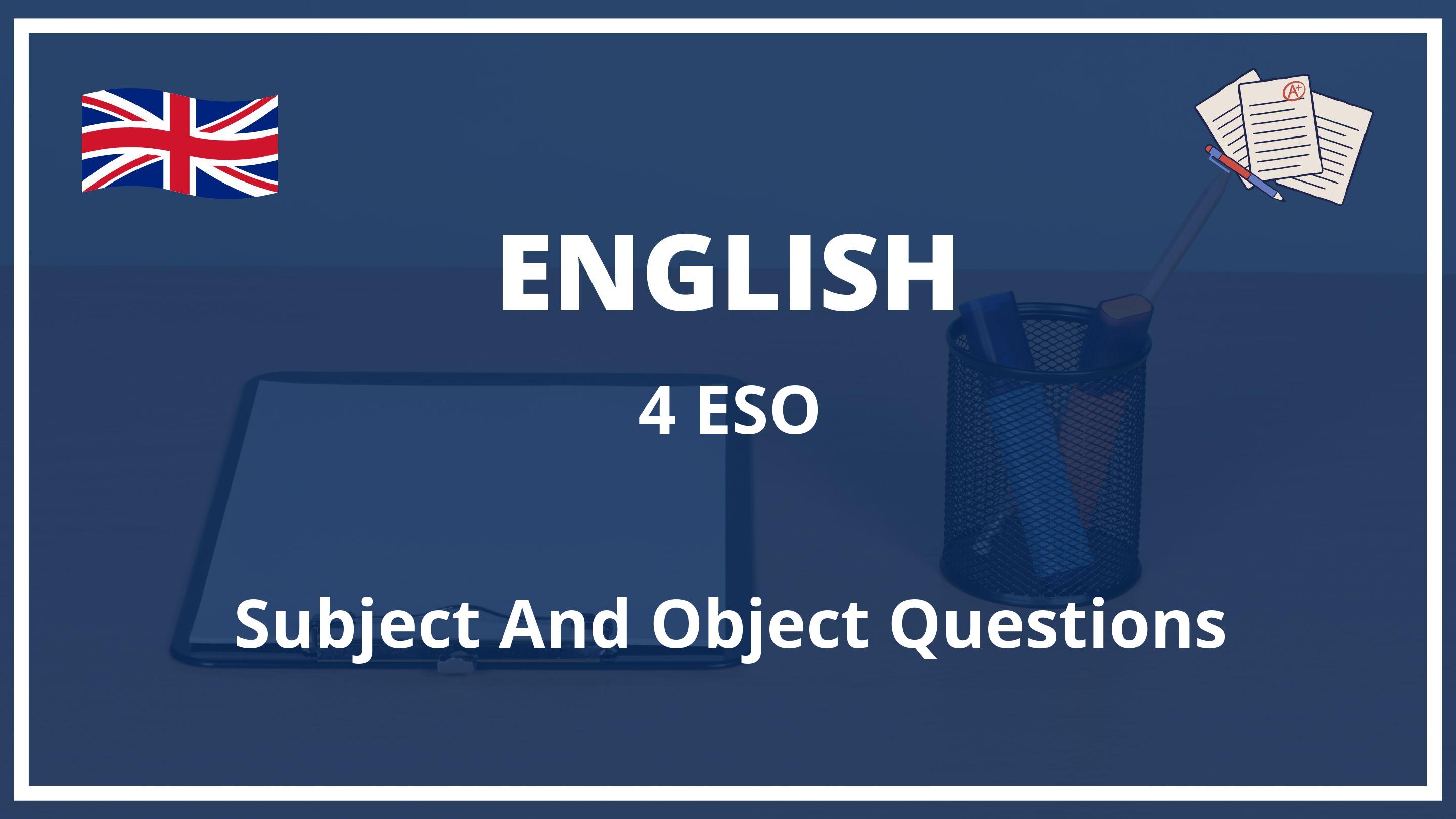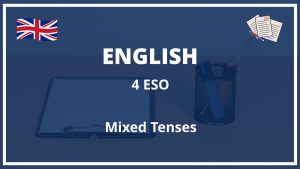
Abrir Ejercicios Subject And Object Questions 4 ESO | Exercices
Subject and Object Questions in English
In English, there are two main types of questions: subject questions and object questions. Subject questions are questions about the subject of the sentence, while object questions are questions about the object of the sentence. Here are some examples:
Subject Question: Who hit the ball?
Object Question: Who did John hit?
As you can see, the subject question is asking about the subject of the sentence (who), while the object question is asking about the object of the sentence (hit). To answer a subject question, you need to use the subject of the sentence (the person or thing doing the action), while to answer an object question, you need to use the object of the sentence (the person or thing receiving the action).
Here are some more examples of subject and object questions:
Subject Question: What happened?
Object Question: What did John see?
Subject Question: When will the meeting start?
Object Question: When will John start the meeting?
Subject Question: Where is my pen?
Object Question: Where is the pen?
Subject Question: Who is that man?
Object Question: Who does that man work for?
Subject Question: Why are you here?
Object Question: Why did John come here?
Subject Question: How are you?
Object Question: How did John feel?
As you can see, subject questions usually start with who, what, when, where, why, or how, while object questions usually start with who, what, when, where, why, or how + did. To answer a subject question, you need to use the subject of the sentence (the person or thing doing the action), while to answer an object question, you need to use the object of the sentence (the person or thing receiving the action).
Ejercicios Resueltos Subject And Object Questions Ingles 4 Eso
Ejercicios Resueltos Subject And Object Questions Ingles 4 Eso
1- Identifica el sujeto y el objeto directo en cada una de las siguientes oraciones:
a) They are watching a movie.They are the subject and «a movie» is the direct object.
b) I am reading a book.I am the subject and «a book» is the direct object.
c) She is writing a letter.She is the subject and «a letter» is the direct object.
d) We are playing tennis.We are the subject and «tennis» is the direct object.
e) They are doing their homework.They are the subject and «homework» is the direct object.
f) I am having breakfast.I am the subject and «breakfast» is the direct object.
g) She is taking a shower.She is the subject and «a shower» is the direct object.
h) We are making a cake.We are the subject and «a cake» is the direct object.
2- Escribe las oraciones anteriores utilizando el verbo to have en lugar del verbo que aparece entre paréntesis:
a) They have a movie.They are the subject and «a movie» is the direct object.
b) I have a book.I am the subject and «a book» is the direct object.
c) She has a letter.She is the subject and «a letter» is the direct object.
d) We have tennis.We are the subject and «tennis» is the direct object.
e) They have homework.They are the subject and «homework» is the direct object.
f) I have breakfast.I am the subject and «breakfast» is the direct object.
g) She has a shower.She is the subject and «a shower» is the direct object.
h) We have a cake.We are the subject and «a cake» is the direct object.
3- Identifica el sujeto y el objeto indirecto en cada una de las siguientes oraciones:
a) She is writing a letter to her friend.She is the subject and «a letter» is the indirect object.
b) We are sending a gift to our parents.We are the subject and «a gift» is the indirect object.
c) I am giving a book to my sister.I am the subject and «a book» is the indirect object.
d) They are buying a house for their family.They are the subject and «a house» is the indirect object.
e) She is cooking dinner for her husband.She is the subject and «dinner» is the indirect object.
4- Escribe las oraciones anteriores utilizando el verbo to have en lugar del verbo que aparece entre paréntesis:
a) She has a letter to her friend.She is the subject and «a letter» is the indirect object.
b) We have a gift to our parents.We are the subject and «a gift» is the indirect object.
c) I have a book to my sister.I am the subject and «a book» is the indirect object.
d) They have a house for their family.They are the subject and «a house» is the indirect object.
e) She has dinner for her husband.She is the subject and «dinner» is the indirect object.
5- Identifica el objeto directo y el objeto indirecto en cada una de las siguientes oraciones:
a) She is writing a letter to her friend.She is the subject and «a letter» is the direct object. «Her friend» is the indirect object.
b) We are sending a gift to our parents.We are the subject and «a gift» is the direct object. «Our parents» is the indirect object.
c) I am giving a book to my sister.I am the subject and «a book» is the direct object. «My sister» is the indirect object.
d) They are buying a house for their family.They are the subject and «a house» is the direct object. «Their family» is the indirect object.
e) She is cooking dinner for her husband.She is the subject and «dinner» is the direct object. «Her husband» is the indirect object.
6- Escribe las oraciones anteriores utilizando el verbo to have en lugar del verbo que aparece entre paréntesis:
a) She has a letter to her friend.She is the subject and «a letter» is the direct object. «Her friend» is the indirect object.
b) We have a gift to our parents.We are the subject and «a gift» is the direct object. «Our parents» is the indirect object.
c) I have a book to my sister.I am the subject and «a book» is the direct object. «My sister» is the indirect object.
d) They have a house for their family.They are the subject and «a house» is the direct object. «Their family» is the indirect object.
e) She has dinner for her husband.She is the subject and «dinner» is the direct object. «Her husband» is the indirect object.
7- Identifica el objeto directo en cada una de las siguientes oraciones:
a) We are watching a movie.We are the subject and «a movie» is the direct object.
b) I am reading a book.I am the subject and «a book» is the direct object.
c) She is writing a letter.She is the subject and «a letter» is the direct object.
d) We are playing tennis.We are the subject and «tennis» is the direct object.
e) They are doing their homework.They are the subject and «homework» is the direct object.
f) I am having breakfast.I am the subject and «breakfast» is the direct object.
g) She is taking a shower.She is the subject and «a shower» is the direct object.
h) We are making a cake.We are the subject and «a cake» is the direct object.
8- Identifica el objeto indirecto en cada una de las siguientes oraciones:
a) She is writing a letter to her friend.She is the subject and «a letter» is the indirect object.
b) We are sending a gift to our parents.We are the subject and «a gift» is the indirect object.
c) I am giving a book to my sister.I am the subject and «a book» is the indirect object.
d) They are buying a house for their family.They are the subject and «a house» is the indirect object.
e) She is cooking dinner for her husband.She is the subject and «dinner» is the indirect object.
9- Completa las siguientes oraciones utilizando el objeto directo o indirecto adecuado:
a) We are sending a gift to our parents.We are the subject and «a gift» is the direct object.
b) I am giving a book to my sister.I am the subject and «a book» is the direct object.
c) They are buying a house for their family.They are the subject and «a house» is the direct object.
d) She is cooking dinner for her husband.She is the subject and «dinner» is the direct object.
10- Escribe las oraciones anteriores utilizando el verbo to have en lugar del verbo que aparece entre paréntesis:
a) We have a gift to our parents.We are the subject and «a gift» is the direct object.
b) I have a book to my sister.I am the subject and «a book» is the direct object.
c) They have a house for their family.They are the subject and «a house» is the direct object.
d) She has dinner for her husband.She is the subject and «dinner» is the direct object.








